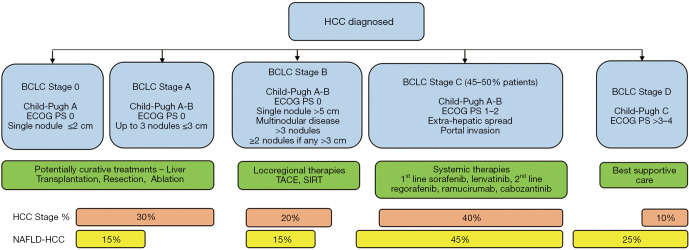Figure 1.
Hepatocellular carcinoma staging and treatment. The EASL guidelines recommend the BCLC algorithm for the management of patients with HCC (45). Patients are classified based on tumour stage, liver function and performance status into four categories (A-D) (blue boxes), with treatments ranging from resection, transplantation and ablation in fitter patients with early disease (BCLC-A), to supportive care in those with advanced HCC in association with poor liver function and/or performance status (BCLC-D) (green boxes). In the populations where HCV cirrhosis is highly prevalent (orange boxes), up to half the patients are suitable for curative or locoregional therapies, with 40% suitable for 1st line medical therapy. In regions where NAFLD is the commonest cause of HCC, the majority of treatable patients are classed BCLC-C (13) and may have age or metabolic syndrome co-morbidities less suitable for medical therapies (yellow boxes). The recent updated EASL guideline supports ECOG-PS stage being attributed to cancer associated symptoms only, potentially enabling an allocation of a patient with physical restrictions impacting performance to BCLC-A or BCLC-B categories, if they have preserved liver function and an earlier stage cancer. In reality, there is little evidence supporting the use of locoregional therapies in these patients. Neither are there evidence based guidelines directing therapies in the absence of cirrhosis. Medical therapies should be considered, but neither elderly patients nor NAFLD patients have been well represented in the clinical trials of medical therapies. HCC, hepatocellular carcinoma; BCLC, Barcelona Clinic for Liver Cancer; EASL, European Association for the Study of the Liver; ECOG-PS, Eastern Cooperative Oncology Group Performance Status; TACE, transarterial chemoembolization; SIRT, selective internal radiotherapy treatment; NAFLD, non-alcoholic fatty liver disease.

